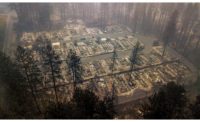As California wildfires flare throughout the state, critics are renewing focus on public utilities’ fire-risk management and prevention strategies. While power shutoffs and vegetation management are being used in the short term, communities are increasingly asking that power lines—the source of several recent wildfires—be buried underground.
Though utility PG&E is burying distribution lines in Paradise, Calif., a town all but destroyed by the 2018 fires, utilities themselves say the cost to bury all lines is prohibitive. According to PG&E estimates, it costs approximately $3 million per mile to convert underground electric distribution lines from overhead, compared with the $800,000-per-mile cost of building overhead lines. Additionally, the underground lines are still at risk from earthquakes, flooding and excavation work. Still, as the damage mounts in California, the option has begun to look more attractive.
Peter Larsen, research scientist and deputy group leader in the electricity markets and policy group at the University of California’s Lawrence Berkeley National Laboratory, says research generally shows that undergrounding costs far exceed benefits. In a study he conducted on the costs of undergrounding in Texas, he found that the cost of undergrounding would exceed benefits by $21 billion—30¢ of benefits for every dollar spent.
California, however, provides a unique case, he says. Larsen says undergrounding should be considered as an effective method for fire-risk prevention when certain factors combine: high-population density; expected fire, storm and severe weather frequency; and vulnerability.
“Those locations where risk is greatest tend to be most difficult—trees and private properties—but on the other side of equation, if you can reduce the risk by overhead lines, you can show without a heroic assumption that the benefits exceed the costs,” he says.
The life-cycle costs of vegetation management of overhead lines also might tip the balance in favor of underground lines.
“It remains to be seen whether utilities find the one-time cost of burying their lines align with their continuing costs of vegetation maintenance and insurance premiums,” says Robert Baylor, director of communications for the National Utility Contractors Association, a Fairfax, Va., trade association representing the utility construction and excavation industry. Some electric utility systems share the cost of excavation with other utilities that also have underground infrastructure needs in the area, such as telecom and cable, he added.
San Diego Gas & Electric began burying transmission lines over a decade ago after it was faulted for sparking major fires that resulted in deaths and economic loss.
But the state’s other major utilities, including PG&E and Southern California Edison, have been slow to implement changes. In July, California Gov. Gavin Newsom (D) signed into law AB 1054, which establishes a Wildfire Fund that mandates public utilities companies to create fire mitigation plans, which include replacing equipment and establishing protocols for public safety power shutoffs.
PG&E says that the scope of the hardening work is dependent on local conditions. “Not every measure, such as undergrounding, is effective at every location,” says Ari Vanrenen, spokesperson for PG&E. “While cost is not directly a factor that is considered, constructibility—the ability to efficiently install the assets per the selected hardening methodology—is.”
James L. Sweeney, director of the Precourt Energy Efficiency Center and professor of management science and engineering at Stanford University, says the higher the voltage, the higher the cost to underground, and notes local low-voltage distribution systems have been relatively easy to underground, which wealthy communities often fund for aesthetic value. But burying lines through locally funded measures could lead to a socioeconomic divide in which richer communities face less fire risk than poor areas.
“I think undergrounding in most cases is a last solution, not a first solution, unless for aesthetic purposes,” Sweeney says. “I don’t think there is a one-size-fits-all cookie-cutter solution.”





